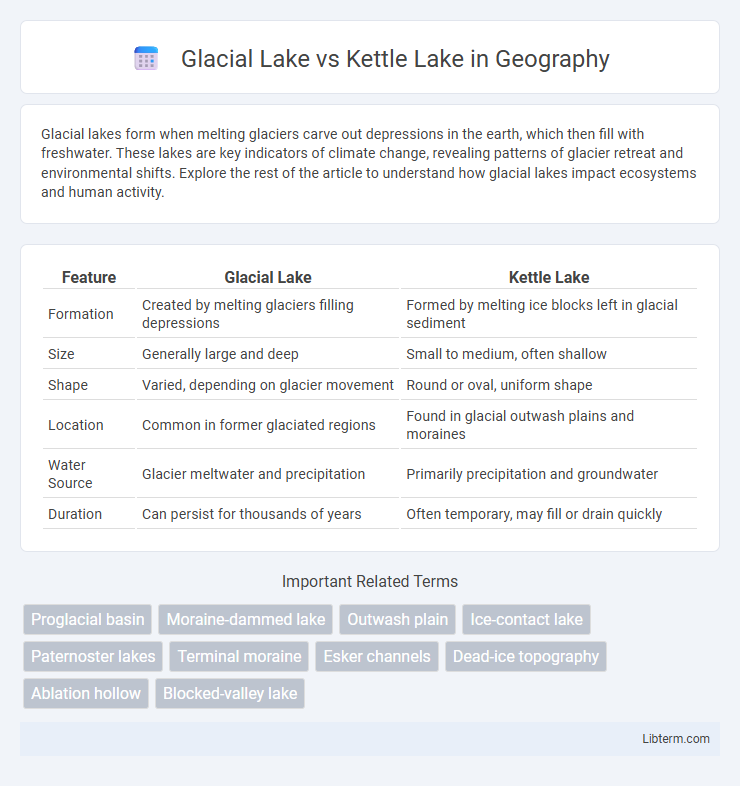Glacial lakes form when melting glaciers carve out depressions in the earth, which then fill with freshwater. These lakes are key indicators of climate change, revealing patterns of glacier retreat and environmental shifts. Explore the rest of the article to understand how glacial lakes impact ecosystems and human activity.
Table of Comparison
| Feature | Glacial Lake | Kettle Lake |
|---|---|---|
| Formation | Created by melting glaciers filling depressions | Formed by melting ice blocks left in glacial sediment |
| Size | Generally large and deep | Small to medium, often shallow |
| Shape | Varied, depending on glacier movement | Round or oval, uniform shape |
| Location | Common in former glaciated regions | Found in glacial outwash plains and moraines |
| Water Source | Glacier meltwater and precipitation | Primarily precipitation and groundwater |
| Duration | Can persist for thousands of years | Often temporary, may fill or drain quickly |
Introduction to Glacial Lakes and Kettle Lakes
Glacial lakes are large bodies of water formed by the melting of glaciers, often characterized by their deep basins and irregular shapes created through glacial erosion and deposition. Kettle lakes, a specific type of glacial lake, form when blocks of ice become buried in glacial sediments and subsequently melt, leaving behind small, round depressions filled with water. These distinctive formations highlight the dynamic processes of glacial retreat and sediment deposition in shaping post-glacial landscapes.
Formation Processes: Glacial Lakes vs Kettle Lakes
Glacial lakes form through the direct scouring or damming of valleys by moving glaciers, creating large basins that fill with meltwater as the ice retreats. Kettle lakes result from blocks of ice left behind by retreating glaciers that become buried in sediment and subsequently melt, leaving behind depressions that collect water. The key distinction lies in glacial lakes being carved by ice movement while kettle lakes originate from isolated ice blocks melting in glacial deposits.
Geological Features and Characteristics
Glacial lakes form when large glaciers retreat, leaving behind extensive depressions filled with meltwater, often characterized by irregular shapes and significant depth. Kettle lakes develop from blocks of ice left in glacial deposits that melt, creating smaller, typically circular lakes with shallow depths and surrounded by sand or gravel basins. Both lake types are crucial indicators of past glacial activity but differ in size, formation processes, and sediment composition.
Size and Depth Comparisons
Glacial lakes typically exhibit larger sizes and greater depths compared to kettle lakes due to their formation by extensive glacial scouring and melting processes. Kettle lakes are generally smaller and shallower, formed by retreating glaciers leaving behind ice blocks that melt and create depressions. Size variations reflect the scale of glacial activity, with glacial lakes spanning several kilometers in diameter, while kettle lakes often range from a few meters to a few hundred meters across.
Water Sources and Hydrology
Glacial lakes primarily receive water from melting glaciers and precipitation, with their hydrology influenced by glacial runoff and seasonal temperature variations. Kettle lakes form from blocks of glacial ice left behind, relying mainly on groundwater inflow, precipitation, and limited surface runoff to maintain their water levels. The distinct formation processes lead to varying hydrologic regimes, where glacial lakes often experience higher water turnover compared to the typically isolated and stable water conditions in kettle lakes.
Ecological Significance and Biodiversity
Glacial lakes, formed by retreating glaciers, often support diverse aquatic ecosystems due to their varying depths and nutrient availability, fostering habitats for fish, amphibians, and migratory birds. Kettle lakes, created by melting ice blocks left in glacial deposits, typically feature nutrient-rich sediments promoting unique wetland vegetation and specialized invertebrate populations. Both lake types play critical roles in regional biodiversity by sustaining distinct ecological niches and supporting species adapted to cold, oligotrophic, or mesotrophic conditions.
Geographical Distribution Around the World
Glacial lakes predominantly form in regions with extensive past or present glaciation, such as North America's Great Lakes area, Scandinavia, and the Alps, where melting glaciers leave behind large basins filled with water. Kettle lakes are commonly found in North America and parts of northern Europe, emerging in landscapes shaped by retreating glaciers that left behind isolated blocks of ice buried in sediment. Both lake types are essential indicators of past glacial activity but differ in size and formation process, influencing their geographical distribution across formerly glaciated terrains.
Human Interaction and Utilization
Glacial lakes, formed by retreating glaciers, often serve as valuable freshwater reservoirs supporting agriculture, hydroelectric power, and recreational activities. Kettle lakes, created by melting ice blocks left in glacial deposits, are typically smaller and more nutrient-rich, making them popular for fishing, wildlife habitats, and localized recreation. Both lake types influence human settlement patterns and environmental management strategies in glaciated regions.
Associated Environmental Challenges
Glacial lakes often face sedimentation and nutrient loading issues due to upstream glacial meltwater carrying fine sediments and organic matter, which can lead to eutrophication and decreased water quality. Kettle lakes, formed by retreating glaciers leaving behind ice blocks, frequently experience limited water circulation, making them susceptible to oxygen depletion and habitat degradation. Both lake types require careful management of surrounding land use to mitigate pollution, invasive species, and the impacts of climate change on hydrology and ecosystem balance.
Key Differences: Glacial Lake vs Kettle Lake
Glacial lakes are typically large water bodies formed by the melting of glaciers and often have irregular shapes with deep basins, while kettle lakes are smaller, round depressions created by retreating glaciers leaving behind ice blocks that later melt. Glacial lakes usually have inflow and outflow channels, influencing their water levels and ecosystems, whereas kettle lakes are often isolated with no surface drainage, resulting in more stagnant water conditions. The sediment composition also differs, with glacial lakes accumulating fine glacial flour, while kettle lakes contain coarser sediments deposited around ice blocks.
Glacial Lake Infographic

 libterm.com
libterm.com